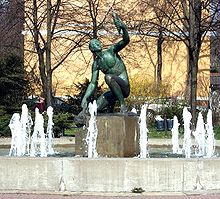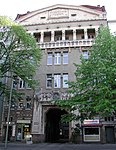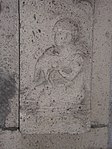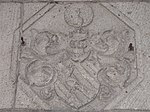Hans Latt
Hans Latt (born May 3, 1859 in Breslau ; † February 27, 1946 in Berlin ; also written Lätt) was a Berlin sculptor who created sculptures in the style of realistic naturalism throughout the city .
Life
From 1878 to 1882 Latt was a student of Robert Härtel at the art school in Breslau. After a two-year study visit to Rome, from 1883 to 1885 with a studio in the Villa Strohl-Fern , he lived in Berlin from 1886 and took part in the Berlin Academy exhibition with an Eros statue in the same year . In 1889 Latt married the writer Annie Felsberg (1850 / 1854–1928; pseudonym: P. Felsberg ).
Latt created statues, busts, reliefs, medals, graves and monuments. Reliefs and sculptures from Latt's workshop, for example, adorned the facade of the Gymnasium zum Grauen Kloster in Berlin-Mitte.
Works in Berlin
Young man with fish (Fischerbrunnen)
The center of this fountain system is the larger than life bronze figure created by Hans Latt of a naturalistically designed naked boy who kneels on a pedestal and holds a fish spouting water in his left hand and a net in his right hand. The time this figure was created is given in various sources between 1925 and 1933. The original location of the youth with fish was the entrance to the Lichtenberger Stadtpark at the end of the short Kielblockstrasse , there was only a simple water basin around it. When a large number of metal works of art were to be melted down at the beginning of the Second World War and used for the production of military equipment, gardeners who looked after the park were able to save the figure from this fate: they courageously hid the boy in a pile of leaves on their base in Rathausstrasse.
After the war, the fishing fountain - with a larger artificial stone basin (diameter 10 meters) and supplemented by twelve white water fountains arranged in a circle around the stone base - was put back into operation. The fountain was given a new location in a small green area on the corner of Frankfurter Allee and Möllendorffstrasse that was created by demolishing an old residential building. In 1970 the fountain system was restored and gives the small, well-kept system its characteristic appearance, it was placed under monument protection.
Boy with a billy goat
Hans Latt created the sculpture from 1918 for the Wertheim department store in Berlin on Leipziger Strasse . Today she stands in front of the police station section 26 in Berlin-Wilmersdorf , Rudolstädter Strasse 79-81. The bronze figure is about 1.20 m high and 2 m long and shows a boy grabbing a billy goat by the horns. The casting was carried out by the court art foundry Martin & Piltzing, Berlin.
mausoleum
The sculpture for the mausoleum of the von Bleichröder banking family on the cemetery in Berlin-Friedrichsfelde , which was demolished around 1950 , was also created by Latt.
Grave figure

Grave complex for the merchant Georg Wolff (1845–1904) and his wife Bertha Wolff on the cemetery IV of the Jerusalem and New Church at Bergmannstrasse 45 in Kreuzberg: the mighty sleeping figure with a beard and large wings obviously represents the pre-Olympic god Chronos , who lives on the island of the blessed in Greek mythology and is a symbol of the passage of time.
Arndt-Herme in the Victoriapark on the Kreuzberg
Hans Latt designed this Herme , which was made from Carrara marble and unveiled in Viktoriapark on April 1, 1899 . The free hand of the poet Ernst Moritz Arndt held a quill pen, while the left hand resting on his chest held the manuscript of the "Eisenliedes" ( The God who made iron grow ). The cloak, which fell from the shoulder, covered the plinth, which was surrounded by an oak leaf feston , in picturesque folds . In the design, the upper body seemed to grow out of a square pillar. The Arndt-Herme was destroyed in the Second World War.
Cecilienhaus
In Berlin-Charlottenburg , Otto-Suhr-Allee 59 (formerly Berliner Straße 137), there is the Cecilienhaus, which was built from 1907–1909 according to plans by the architect and Charlottenburg urban planning inspector Walther Spickendorff with the assistance of the architect Adolf Stein and the urban planning inspector Rudolf Walter . It was named after the then Crown Princess Cecilie . The building was built for the Patriotic Women's Association in Charlottenburg, founded in 1879 , and inaugurated on May 2, 1909. In the 1920s and 1930s the Cecilienhaus was the headquarters for the charities in Charlottenburg with a gynecological clinic and maternity ward. As director of the German Institute for Women's Research, the gynecology professor Wilhelm Liepmann (1878–1939) became director of the clinic in 1925 (due to his Jewish descent, he fled Germany in 1933). Of the original building, which was grouped around four courtyards, only a complex with two courtyards is left after destruction and some renovations. The Cecilienhaus complex is a listed building . The numerous decorative elements on the main building are designed in decorative Art Nouveau forms, but some details in the passageways and in the plinth area are not in good condition. The sculptural work was carried out by Joseph Breitkopf-Cosel (1876–1927), Fritz Heinemann and Hans Latt.
- Jewelry at the Cecilienhaus
Other works
Latt also made designs for the Königliche Porzellan-Manufaktur Berlin . The model book entries in the KPM archive in Charlottenburg Palace show that the two candelabras shown were made together with a mantelpiece based on designs by Hans Latt. But the watch has been lost. The male figure is under the model no. 6330 (February 1900), the female under model no. 6351 (March 1900). The mantel clock was launched in December 1899 under the model no. 6278 included in the model book. In 2014 the pair of candlesticks were re-issued by KPM.
An old encyclopedia contains the following text about an art exhibition in Germany (Dresden 1890), which reproduces Latt's Credo and describes another work:
“... to design like nature itself and to exploit the beauty and grace of the human body in all its advantages for plastic art. Hans Latt emerged through the figure of a nymph , which shows a serious study of the naked body, watering a snake ... "
literature
- Latt, Hans . In: Hans Vollmer (Hrsg.): General lexicon of fine artists from antiquity to the present . Founded by Ulrich Thieme and Felix Becker . tape 22 : Krügner – Leitch . EA Seemann, Leipzig 1928, p. 426 .
- Cornelius Stecker: Museum Friedhof. Berlin 1984.
- Peter Bloch, Sibylle Einholz, Jutta von Simson (eds.): Ethos and Pathos. The Berlin School of Sculpture 1786-1914. Berlin 1994, Volume II: Short Biographies. (edited by Sibylle Einholz and Brigitte Hüfler).
- Jörg Haspel, Klaus von Krosigk (eds.): Gartendenkmale in Berlin (= contributions to the preservation of monuments in Berlin. Volume 27.) Petersberg 2008, ISBN 978-3-86568-293-2 , p. 67 and p. 98.
- Hainer Weißpflug: Cecilienhaus . In: Hans-Jürgen Mende , Kurt Wernicke (Hrsg.): Berliner Bezirkslexikon, Charlottenburg-Wilmersdorf . Luisenstadt educational association . Haude and Spener / Edition Luisenstadt, Berlin 2005, ISBN 3-7759-0479-4 ( luise-berlin.de - as of October 7, 2009).
Web links
Individual evidence
- ↑ Fishing fountain
- ↑ Zentralfriedhof Friedrichsfelde (socialist cemetery) - tomb v. Bleichröder. Sozialistenfriedhof.de, accessed on November 21, 2019 .
- ↑ Ali Vicdani Doyum: Alfred Kantorowicz with special reference to his work in İstanbul (A contribution to the history of modern dentistry). 1985, pp. 50 and 66-68.
- ^ Andreas D. Ebert, Arin Namal: Wilhelm Gustav Liepmann (1878–1939) - expulsion from the first chair for social gynecology at the Berlin University to the University of Istanbul. In: Matthias David, Andreas D. Ebert (Ed.): History of the Berlin University Women's Clinics. Structures, people and events inside and outside the Charité. Walter de Gruyter, 2010, pp. 238–250.
- ^ The Cecilien House in Charlottenburg. Zentralblatt der Bauverwaltung, 1909, accessed on September 6, 2019 .
- ↑ KPM is releasing candlesticks based on a design by Hans Latts. In: Berliner Morgenpost. February 8, 2014 ( morgenpost.de ).
- ↑ Art exhibitions d. J. 1890 in Germany (Dresden) . In: Meyers Konversations-Lexikon . 4th edition. Volume 18, Verlag des Bibliographisches Institut, Leipzig / Vienna 1885–1892, p. 541.
| personal data | |
|---|---|
| SURNAME | Latt, Hans |
| ALTERNATIVE NAMES | Lätt, Hans (spelling) |
| BRIEF DESCRIPTION | German sculptor |
| DATE OF BIRTH | May 3, 1859 |
| PLACE OF BIRTH | Wroclaw |
| DATE OF DEATH | February 27, 1946 |
| Place of death | Berlin |







